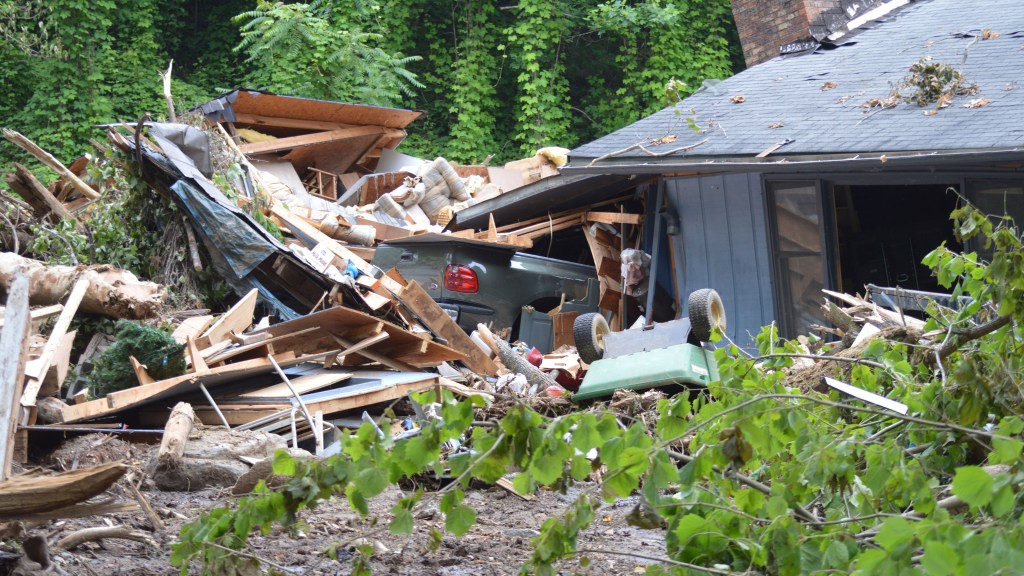Through the eyes of Polk County’s rescuers
Published 11:46 am Monday, June 25, 2018

- During the evening of May 18 — when the region was impacted by a series of mudslides — rescue workers battled rain, mud, moving water, downed power lines and poisonous snakes in the pitch dark to try to save Tryon’s Patricia Case, who had been swept away by the mud. (Photo by Catherine Hunter/Tryon Daily Bulletin)
Tryon firefighters share what happened the night of the May 18 mudslides
Inspired by conversations with Tryon firefighters and emergency personnel, this is the first in a series of articles describing the natural disasters that occurred in Pacolet Valley and other portions of Western Polk County on Friday, May 18, and the days that followed.
TRYON — “We have someone trapped. We need all the resources and manpower you can get,” came the 911 call from Tryon Firefighter Chris Ross that fateful Friday night of May 18.
Tryon Fire Chief Geoffrey Tennant replied that he was sending another three or four rescue personnel in.
“[Ross] said that wouldn’t be nearly enough,” Tennant said. “He said we needed everything on the scene we could get.”
More than month following the series of mudslides that left a Tryon woman dead, Tennant and Assistant Fire Chief James “Tank” Waters are sharing what happened that night and the week that followed. They wish to tell the stories of the emergency personnel who did their best to handle the devastating events.
Tennant and Waters said they wanted to be as transparent as possible regarding the actions of the emergency efforts, in the hope it might help people be safer in the future if they are
informed.
Tennant said the first storm-related call that night came around 9 p.m. for two motorists trapped in a car by running water on Highway 176. He said three or four rescue workers went out, and were able to help the two ladies to safety.
“At that time, [Tryon’s] Leon Case approached them saying his wife [Patricia] was buried in a mudslide,” Tennant said.
Along with Ross, firefighters Roger Walker and Ivan Cunningham waded through chest deep mud using only flashlights to see in the pitch black and pouring rain.
“They had to take a step forward holding onto the person behind them,” Waters said. “Then they had to reach back and pull that person a step forward. They made that trip in and out three or four times.”
Waters said the men wading through the chest deep mud in the dark and the pouring rain had no way of knowing whether there was another mudslide coming to sweep them away.
“In all that mud, you can’t run,” he said. “You’re a sitting duck.”
Tennant explained that once the firefighters had waded through the mud to assess the situation, they had to make their way back out to the trucks for equipment.
When they realized what they were up against, the firefighters tried to use their walkie-talkies and cell phones to call for more help, but those devices were not working. They finally made their way back through the mud to the Tryon Youth Center, where they were able to call 911 from a landline that was still
intact.
By 11 p.m., Tennant and Waters began talking with Polk County Emergency Management Director Bobby Arledge.
Tennant said Arledge immediately called the state requesting special technicians on the scene. Though they were doing their best and putting their lives at risk, Polk County rescue personnel are simply not trained for that kind of rescue, Tennant said.
That night, rescue teams not only worked in swift-moving water full of rocks and trees, they were threatened by downed, live power lines and poisonous snakes that had been dislodged by the mudslides.
“They were in danger of being swept away or even being buried alive themselves,” Waters said.
While specialty teams and rescue workers were searching for Patricia Case, other crews had brought in an excavator and two backhoes, and were attempting to clear enough of the mud and debris from 176 so they could get rescue equipment in to the scene.
“They were still trying to carry everything in by hand through chest deep mud in the pitch dark,” Waters said.
Though they worked diligently, in the pitch dark, the backhoe and excavator operators had no idea how to safely or even effectively clear the area because they couldn’t see. As they tried to clear away the mud, rocks and trees, they had no idea if they were dislodging a slide that would sweep them away
as well.
Waters said they worked for hours in an effort to rescue Patricia.
By 2:30 a.m., they realized it was a recovery effort rather than a rescue, and had to make the difficult decision to pull back for the safety of the emergency personnel.
It was indescribably difficult for the rescue workers to pull back and wait until daylight to continue their efforts, Waters said.
“That’s the way we are. We don’t believe it until we see the proof,” he said. “We just want to keep going. Just another five minutes.”
As daylight broke around 6:30 a.m., they immediately continued search efforts and completed the recovery by 8:30 a.m.
At 6:30 a.m., authorities also began an effort to assess the damage. Though they had continued to receive 911 calls throughout the night from people trapped in vehicles or trees down on houses, they had no way of knowing the true extent of the storm’s damage.
“None of us understood what we were facing Friday night,” Tennant said. “You couldn’t see until the sun came up the next morning.”





